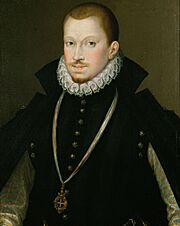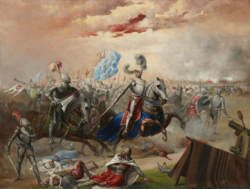Battle of Alcácer Quibir facts for kids
Quick facts for kids Battle of Alcácer Quibir |
|||||||
|---|---|---|---|---|---|---|---|
| Part of the Moroccan-Portuguese conflicts | |||||||
 Battle at Ksar el Kebir, depicting the encirclement of the Portuguese army on the right |
|||||||
|
|||||||
| Belligerents | |||||||
Mercenaries from: |
|
||||||
| Commanders and leaders | |||||||
|
|
||||||
| Strength | |||||||
|
23,000 men
including:
|
60,000–100,000 men 34 cannons |
||||||
| Casualties and losses | |||||||
| 8,000 killed 15,000 captured or 12,000 killed (Spanish sources) |
7,000 killed (Portuguese sources) or 1,500 killed (Spanish sources) |
||||||
The Battle of Alcácer Quibir was a huge battle fought in northern Morocco on August 4, 1578. It is also known as the "Battle of Three Kings" or "Battle of Wadi al-Makhazin." This fight took place near the town of Ksar-el-Kebir.
The battle was a big win for Morocco. It's often called the worst military disaster Portugal ever faced. After this battle, Portugal stopped trying to take back lands it had lost in Morocco.
The main people fighting were the army of Abu Abdallah Mohammed II, who was the former Sultan of Morocco, and his friend, Sebastian I, the King of Portugal. They fought against a large Moroccan army led by the new Sultan, Abd Al-Malik I. Abd Al-Malik was Abu Abdallah's uncle.
King Sebastian wanted to start a religious war to help Abu Abdallah get his throne back. Abd Al-Malik had taken the throne from his nephew with help from the Ottoman Empire. Portugal's defeat and the disappearance of King Sebastian, who had no children, led to the end of his family's rule. Portugal then became part of the Iberian Union with Spain for 60 years.
Contents
Getting Ready for Battle

King Sebastian's Plan
King Sebastian of Portugal was born after his father died. He became king at just three years old in 1557. He was taught mostly by Jesuits and his grandmother. Some people later said his strong beliefs turned into extreme religious ideas.
People in Portugal asked Sebastian to go to Morocco many times. They wanted him to stop the growing power of the Ottoman Turks. The Ottomans were a threat to Portugal's coasts and trade routes.
Sebastian decided to act when Abu Abdallah, the former Moroccan Sultan, asked for his help. Abu Abdallah wanted to get his throne back from his uncle, Abd Al-Malik. Sebastian felt he could bring back Portugal's past glories by getting involved in North Africa. He was encouraged by a successful defense of Mazagan against a Moroccan attack in 1562. So, in 1568, Portugal began to prepare for war in Morocco.
This plan was popular with both traders and nobles. Traders hoped it would help with business, especially in gold, cattle, wheat, and sugar. Before this, Portugal's military actions in Africa were small. Portugal had built its large empire through trade and sea exploration. Sebastian wanted to change this and go much bigger.
In 1574, Sebastian visited some Portuguese bases in North Africa. He led a successful attack on Muslim land beyond Tangier. He won several small fights, which made him want to do even bigger things against the new Moroccan ruler. He supported Abu Abdallah, who was fighting a civil war against his uncle, Abd Al-Malik. Abd Al-Malik was helped by the Ottomans.
Even though his mother and his uncle, Philip II of Spain, warned him, Sebastian was set on this military campaign. He used much of Portugal's wealth to get a large fleet and an army. This army included soldiers from many places: 2,000 volunteers from Spain, 3,000 hired soldiers from Flanders and Germany, and 600 Italians. The expedition had about 500 ships and around 18,000 soldiers. Many of Portugal's important nobles were part of this army.
Sultan Abd al-Malik's Army
Meanwhile, Morocco was ruled by the Saadi Sultanate. This family came to power by fighting against the Portuguese in Agadir. By the 1550s, they controlled most of Morocco. When Sultan Abdallah al-Ghalib died in 1574, his son, Abu Abdallah, became ruler. But two years later, his uncle, Abd al-Malik, took over.
Abd al-Malik had gone to Istanbul in 1574 and got help from the Ottoman Sultan. With Ottoman troops, Abd al-Malik defeated his nephew near Fez. Once he was Sultan, he showed he was loyal to the Ottomans. He used Ottoman styles for his clothes and organized his army like the Ottomans. Turkish officers helped him train his soldiers.
The Saadi army had local soldiers, cavalry with guns, infantry with rifles, and many light cavalry. They also had artillery. Many soldiers were from Al-Andalus, who had been forced out of Spain. Others were from Berber tribes and former Ottoman soldiers.
The Campaign
King Sebastian left the port of Lagos with his fleet on June 24, 1578. He had given a speech to his troops before they left.
He landed at Arzila, a Portuguese area in Morocco. There, Abu Abdallah joined him with 6,000 more allied Moroccan soldiers. They then marched inland.
Abd al-Malik I, who was very sick, had gathered a large army. He called on his people to fight a holy war against the Portuguese invaders. The two armies came close to each other near Ksar-el-Kebir. They camped on opposite sides of the Loukkos River.
The Battle Begins
On August 4, 1578, the Portuguese and their Moroccan allies got ready for battle. King Sebastian rode around, cheering on his soldiers. But the Moroccan army moved forward in a wide line, planning to surround Sebastian's army.
The Sultan had 10,000 cavalry (soldiers on horseback) on the sides. In the middle, he placed Moors who had been forced out of Spain. These soldiers had a special anger towards Christians. Even though he was sick, the Sultan left his bed and led his forces on horseback.
The battle started with both sides firing many shots from guns and cannons. Thomas Stukley, who led the Portuguese center, was killed by a cannonball early in the fight. The Moroccan cavalry then moved forward and began to surround the Portuguese army. Soon, both armies were fighting hand-to-hand.
The sides of the Portuguese army started to break under the Moroccan cavalry's attack. Eventually, the middle of the Portuguese army was also in danger. Seeing their sides collapsing and having lost their leader, the Portuguese center lost hope and was defeated.
The battle lasted almost four hours of heavy fighting. It ended with a complete defeat for the Portuguese and Abu Abdallah's army. About 8,000 soldiers died, including almost all of Portugal's nobles. Another 15,000 were captured and sold into slavery. Only about 100 survivors managed to escape to the coast. King Sebastian, who charged into the enemy and was cut off, was never found.
Sultan Abd Al-Malik died during the battle from his illness. The effort of riding was too much for him. His troops kept his death a secret until they had won completely. Abu Abdallah tried to run away but drowned in the river. Because King Sebastian, Abu Abdallah, and Abd Al-Malik all died during the fighting, the battle became known in Morocco as the Battle of the Three Kings.
What Happened Next
Abd Al-Malik's brother, Ahmad al-Mansur, became the new Sultan. He later conquered Timbuktu, Gao, and Jenne after defeating the Songhai Empire. The Moroccan army that invaded Songhai in 1590–91 had many European captives. Some of these were Portuguese soldiers taken prisoner at the Battle of Alcácer Quibir.
For Portugal, the battle was a huge disaster. King Sebastian died, along with most of Portugal's important nobles. The captured nobles had to be bought back, which almost made Portugal go bankrupt. Even though his body was not found, Sebastian was believed to be dead at 24 years old. He had never married and had no children to take his place.
His old, childless uncle, Henry of Portugal, who was a cardinal, became the next king. His short rule (1578–1580) was spent trying to pay the huge costs from the Morocco disaster. After his death, other people who wanted to be king of Portugal were defeated by a Spanish army. Philip II of Spain, who was Sebastian's uncle, invaded with 40,000 men. He defeated the Portuguese forces and was crowned Philip I of Portugal in 1581.
Later, Philip II ordered that the remains believed to be Sebastian's be returned to Portugal. They were buried at the Jerónimos Monastery in Lisbon. Portugal and its empire were not officially made part of the Spanish Empire. They remained a separate kingdom under the Spanish rulers until 1640, when Portugal broke away.
Because of this terrible defeat, a belief called 'Sebastianism' grew in Portugal. It was like the legend of King Arthur. People believed that their lost king would one day return to save the nation. This legend has been important in Portuguese life ever since.
In Stories and Games
- The battle is featured in the English play The Battle of Alcazar by George Peele. It's also a main event in The Famous History of the Life and Death of Captain Thomas Stukeley.
- The battle is shown in the 1990 film The Battle of the Three Kings.
- The 1990 film "Non", ou A Vã Glória de Mandar by Portuguese director Manoel de Oliveira also shows the battle.
- The battle is a historical mission in the 2020 video game Age of Empires III: Definitive Edition. It is called "The Battle of the Three Kings."
See also
- History of Morocco
- History of Portugal
- Military history of Morocco
- Military history of Portugal


